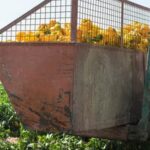Vertical gardening vegetables has become increasingly popular due to its space-saving capabilities and the ability to grow fresh produce in limited areas. In this article, we will explore the world of vertical gardening, specifically focusing on cultivating a variety of vegetables in a vertical garden. From the benefits and best vegetables for vertical gardening to soil and fertilizer requirements, container options, maintenance tips, creative ideas for small spaces, and the harvesting process – we will cover it all.
Vertical gardening is a method of growing plants upwards rather than outwards, making it ideal for urban dwellers or those with limited outdoor space. This innovative approach not only maximizes space but also adds aesthetic appeal to any living environment. When it comes to growing vegetables in a vertical garden, there are specific considerations that need to be taken into account in order to ensure successful growth and bountiful harvests.
Throughout this article, we will delve into the various aspects of vertical gardening vegetables, providing valuable insights and practical advice on how to create and maintain your very own vertical vegetable garden. Whether you’re a novice gardener or have some experience with traditional gardening methods, this guide will equip you with the knowledge and tools needed to embark on a rewarding journey of growing fresh and nutritious produce right at your fingertips.
Benefits of Vertical Gardening for Vegetables
Vertical gardening has gained popularity in recent years due to its numerous benefits, especially when it comes to growing vegetables. One of the main advantages of vertical gardening for vegetables is that it allows individuals with limited space to still enjoy the satisfaction of growing their own produce.
Whether you live in a small apartment or have a tiny backyard, vertical gardening provides the opportunity to cultivate a wide variety of vegetables without the need for a large traditional garden plot.
Another benefit of vertical gardening for vegetables is its potential for increased crop yields. By utilizing vertical space, such as walls and trellises, gardeners can maximize their growing area, leading to a higher vegetable output compared to traditional horizontal gardens. This is particularly advantageous for individuals looking to grow their own fresh and organic produce, as vertical gardening can provide an abundance of vegetables throughout the growing season.
In addition, vertical gardening for vegetables can also help protect crops from pests and diseases. By keeping plants off the ground and utilizing techniques like companion planting, gardeners can naturally discourage unwanted insects and minimize the risk of soil-borne illnesses. Overall, vertical gardening offers a sustainable and efficient way to cultivate a bountiful harvest of nutritious and flavorful vegetables.
| Benefit | Explanation |
|---|---|
| Space Efficiency | Allows individuals with limited space to still enjoy growing their own produce. |
| Increased Yields | Maximizes growing area, leading to higher vegetable output compared to traditional gardens. |
| Pest and Disease Control | Protects crops from pests and diseases by keeping plants off the ground. |
Best Vegetables for Vertical Gardening
When it comes to vertical gardening vegetables, choosing the right plants is essential for a successful and fruitful harvest. Not all vegetables are suitable for vertical gardening, as some may require more space or support than others. However, there are several vegetables that thrive in a vertical garden and can be easily grown in containers or on trellises. Here are some of the best vegetables for vertical gardening:
- Tomatoes: Tomatoes are a popular choice for vertical gardening, as they can be trained to grow upwards with the help of a sturdy trellis or cage. They come in various sizes and varieties, making them versatile and suitable for small spaces.
- Cucumbers: Cucumbers are vining plants that can be grown vertically on trellises. Vertical growing helps prevent pest and disease issues by keeping the fruit off the ground, and also saves space in the garden.
- Peas: Peas are well-suited for vertical gardening due to their climbing nature. They can be grown on trellises or netting, allowing them to reach their full height while taking up minimal space.
In addition to these vegetables, other suitable options for vertical gardening include beans, peppers, and even certain leafy greens like spinach or lettuce if provided with adequate support.
Choosing any of these vegetables for your vertical garden will not only save you valuable space but also make it easier to care for and harvest your crops. With proper planning and care, you can enjoy a bountiful harvest of home-grown produce from your vertical garden throughout the growing season.
Soil and Fertilizer Requirements for Vertical Gardening Vegetables
When it comes to vertical gardening vegetables, proper soil and fertilizer are crucial for the success of your plants. Since vegetables require a nutrient-rich environment to thrive, it’s important to understand the specific soil and fertilizer requirements for vertical gardening.
For soil, it’s best to use a lightweight potting mix that provides good drainage. This is especially important in vertical gardens where excess water can easily accumulate. Look for a high-quality potting mix that contains organic matter and enough nutrients to support the growth of vegetables. You can also consider adding perlite or coarse sand to improve drainage and aeration.
In terms of fertilizers, organic options are often preferred for vegetable gardens as they provide a slow release of nutrients over time. Consider using compost or well-aged manure to enrich the soil and promote healthy plant growth. Additionally, you can incorporate organic liquid fertilizers into your watering routine to supplement the nutrient needs of your vertical gardening vegetables.
To ensure that your vertical gardening vegetables have the best possible start, here are some recommended soil and fertilizer requirements:
- Use lightweight potting mix with good drainage
- Consider adding perlite or coarse sand to improve aeration
- Opt for organic fertilizers such as compost or well-aged manure
- Supplement with organic liquid fertilizers for additional nutrients
By meeting the soil and fertilizer requirements for your vertical gardening vegetables, you can create an optimal growing environment that promotes healthy plant development and bountiful harvests.
Choosing the Right Containers for Vertical Gardening
When it comes to growing vegetables in a vertical garden, choosing the right containers is crucial for the success of your plants. The containers you select will impact factors such as water retention, root space, and overall health of the vegetables. Look for containers that are specifically designed for vertical gardening, or get creative and repurpose items such as hanging shoe organizers, wooden pallets, or PVC pipes.
One popular option for vertical gardening containers is the use of fabric pots. These containers provide excellent drainage and aeration for the plant roots, which can lead to healthier and more productive vegetable plants. Additionally, fabric pots are lightweight and easy to move around, making them perfect for vertical gardening where space may be limited.
Another important consideration when choosing containers for vertical gardening vegetables is size. Depending on the vegetable you want to grow, you’ll need to select a container size that provides enough room for root development. For example, larger vegetables like tomatoes or peppers will require bigger containers with ample depth for their roots to spread out.
It’s important to remember that no matter what type of container you choose for your vertical gardening vegetables, proper drainage is essential. Without adequate drainage, excess water can accumulate in the soil and lead to root rot or other moisture-related issues.
| Container Type | Benefits |
|---|---|
| Fabric Pots | Excellent drainage and aeration; lightweight and portable |
| Repurposed Items (e.g. shoe organizers) | Eco-friendly option; can be customized for different vegetable types |
| Traditional Planters with Proper Drainage Holes | Durable option; available in various sizes and materials |
Tips for Success in Vertical Gardening
Vertical gardening vegetables can be a great way to maximize space and yield a bountiful harvest, but it requires some careful planning and maintenance. Here are some tips for success in vertical gardening vegetables:
First, choose the right location for your vertical garden. Most vegetables require at least 6-8 hours of sunlight per day, so make sure your vertical garden is placed in an area that receives adequate sunlight. If you are using a container or hanging system, ensure that it is secure and properly supported to avoid any accidents.
Next, consider the irrigation needs of your vertical gardening vegetables. The nature of vertical gardening can affect the water retention of the soil, so be mindful of watering frequency and drainage. Automatic watering systems or self-watering containers can be helpful in maintaining consistent moisture levels for your vegetables.
Additionally, proper support is crucial for many vegetable plants in a vertical garden. Utilize trellises, stakes, or cages to support vining plants like tomatoes, cucumbers, and peas as they grow upwards. This will help prevent damage to the plants and encourage healthy growth.
By practicing these tips for success in vertical gardening vegetables, you can overcome the challenges of limited space and enjoy a flourishing harvest of fresh produce right from your own home. With careful planning and maintenance, you can create a thriving vertical garden full of delicious and nutritious vegetables.
Maintenance and Care for Vertical Gardening Vegetables
Watering
One of the most important aspects of maintaining a successful vertical garden for vegetables is proper watering. Because the plants are grown in containers, they can dry out quickly, especially during hot summer months. It’s essential to monitor the moisture level of the soil and water the plants accordingly.
Overwatering can lead to root rot, while underwatering can cause stunted growth and wilted leaves. Consider installing a drip irrigation system or self-watering containers to make this task more manageable.
Weeding and Pest Control
Just like traditional ground-level gardens, vertical gardening for vegetables requires regular weeding to prevent unwanted plants from taking nutrients from your vegetables. Additionally, pests and diseases can still affect your vertical garden, so it’s crucial to inspect your plants regularly and take necessary measures to control any infestations. Utilize organic pest control methods whenever possible to protect both your plants and the environment.
Pruning and Trellising
As your vegetables grow vertically, they may require some assistance in staying upright and preventing overcrowding. Regular pruning of dead or diseased plant parts is essential for maintaining healthy growth. Additionally, providing appropriate trellises or supports for climbing vegetables like tomatoes, cucumbers, and peas will help them thrive in a vertical gardening setup. Properly trained vines will also encourage air circulation, which reduces the risk of fungal diseases.
Creative Ideas for Vertical Gardening in Small Spaces
One of the main advantages of vertical gardening is its suitability for small spaces. This type of gardening allows you to make use of vertical spaces, such as walls, fences, and balconies, to grow vegetables without taking up valuable floor space. Vertical gardening in small spaces opens up a world of creative possibilities and can be an attractive and functional addition to your home.
Vertical Wall Planters
For those with limited ground space, vertical wall planters are a great option. These planters can be attached to outdoor walls or even indoor walls with proper lighting. They come in various sizes and designs, allowing you to grow a variety of vegetables like cherry tomatoes, lettuce, and herbs. Vertical wall planters not only provide you with fresh produce but also serve as beautiful living decorations.
Hanging Baskets
Hanging baskets are another clever way to maximize vertical space for gardening. They can be hung from ceilings or on hooks attached to walls or railings. Cascading vegetables like strawberries or trailing herbs flourish in hanging baskets and add a vibrant touch to any small space.
Pallet Gardening
Repurposing wooden pallets into vertical gardens is an eco-friendly way to transform unused spaces into thriving vegetable beds. By adding shelves or pockets, pallets can accommodate various types of vegetables, making them an excellent choice for those looking for a sustainable approach to gardening in small areas.
Harvesting and Enjoying the Fruits of Your Vertical Gardening Labor
In conclusion, vertical gardening vegetables is a great way to maximize space and grow your own fresh produce. The benefits of vertical gardening for vegetables are numerous, including saving space, reducing the risk of pests and diseases, and making it easier to harvest. By choosing the right containers, soil, and fertilizer, as well as following some tips for success, you can enjoy a bountiful harvest of delicious vegetables from your vertical garden.
When it comes to choosing the best vegetables for vertical gardening, there are many options to consider. From leafy greens like spinach and lettuce to vining plants like tomatoes and cucumbers, there is no shortage of choices for what you can grow vertically. With the right maintenance and care, along with creative ideas for small spaces, you can create a beautiful and productive vertical garden that will provide you with fresh vegetables throughout the growing season.
Overall, vertical gardening is a versatile and efficient way to grow vegetables in limited space. Whether you have a small balcony or a tiny backyard, vertical gardening allows you to enjoy the satisfaction of growing your own food. By using this method, you can make the most of your available space while reaping all the benefits that come with harvesting and enjoying the fruits of your vertical gardening labor.
Frequently Asked Questions
What Vegetables Work Well in a Vertical Garden?
Many vegetables are suitable for vertical gardens, including tomatoes, peppers, cucumbers, and peas. These plants can thrive in the confined space of a vertical garden and can be easily trained to grow upwards.
What Are Disadvantages of Vertical Gardens?
Some disadvantages of vertical gardens include the need for careful watering to prevent water from dripping onto lower plants or structures, the potential for more rapid drying out of soil, and the initial cost and effort required to set up the vertical garden structure.
What Grows Well in a Vertical Planter?
Various herbs like thyme, rosemary, and oregano grow well in vertical planters due to their shallow root systems and ability to thrive in small spaces. Additionally, leafy greens such as lettuce and spinach can also do well in vertical planters.

If you’re looking to get into vegetable gardening, or are just looking for some tips on how to make your current garden better, then you’ve come to the right place! My name is Ethel and I have been gardening for years. In this blog, I’m going to share with you some of my best tips on how to create a successful vegetable garden.





